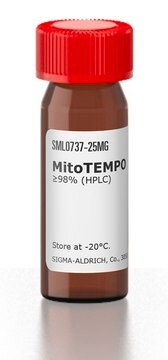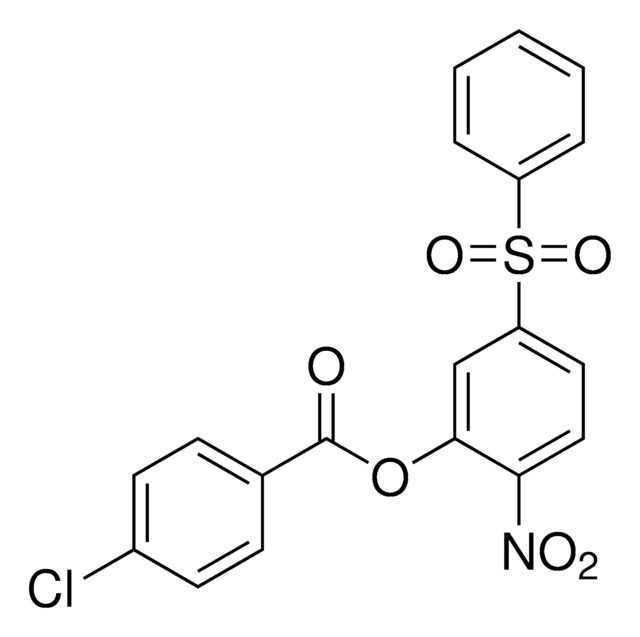C2759
Carbonyl Cyanide m-Chlorophenylhydrazone
≥97% (TLC), powder, mitophagy inducer
Sinónimos:
m-Cl-CCP, CCCP, Mesoxalonitrile 3-chlorophenylhydrazone
About This Item
Productos recomendados
Nombre del producto
Carbonyl cyanide 3-chlorophenylhydrazone, ≥97% (TLC), powder
assay
≥97% (TLC)
form
powder
color
yellow to orange
solubility
DMSO: 100 mM
storage temp.
−20°C
SMILES string
Clc1cccc(N\N=C(\C#N)C#N)c1
InChI
1S/C9H5ClN4/c10-7-2-1-3-8(4-7)13-14-9(5-11)6-12/h1-4,13H
InChI key
UGTJLJZQQFGTJD-UHFFFAOYSA-N
¿Está buscando productos similares? Visita Guía de comparación de productos
Application
- in the inhibition of efflux pump in clinical Pseudomonas aeruginosa
- to inhibit oxidative phosphorylation activity of mitochondria in human Beas-2B bronchial epithelial cells
- to prepare carbonyl cyanide m-chlorophenylhydrazone solution for oxidative and mitochondrial stress assay and mitophagy induction in Caenorhabditis elegans
Biochem/physiol Actions
signalword
Danger
Hazard Classifications
Acute Tox. 3 Dermal - Acute Tox. 3 Inhalation - Acute Tox. 3 Oral - Eye Irrit. 2 - Skin Irrit. 2 - STOT SE 3
target_organs
Respiratory system
Storage Class
6.1C - Combustible acute toxic Cat.3 / toxic compounds or compounds which causing chronic effects
wgk_germany
WGK 3
ppe
Eyeshields, Faceshields, Gloves, type P2 (EN 143) respirator cartridges
Elija entre una de las versiones más recientes:
¿Ya tiene este producto?
Encuentre la documentación para los productos que ha comprado recientemente en la Biblioteca de documentos.
Los clientes también vieron
Contenido relacionado
DISCOVER Bioactive Small Molecules for Nitric Oxide & Cell Stress Research
Nuestro equipo de científicos tiene experiencia en todas las áreas de investigación: Ciencias de la vida, Ciencia de los materiales, Síntesis química, Cromatografía, Analítica y muchas otras.
Póngase en contacto con el Servicio técnico











